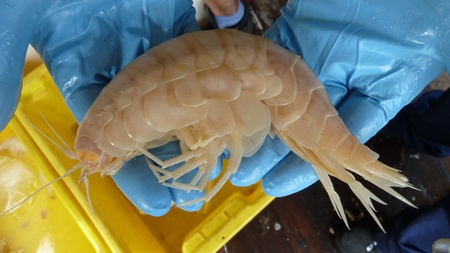An expedition to one of the deepest places in the ocean has discovered one of the most enigmatic creatures in the deep sea - the 'supergiant' amphipod.
Amphipods are a type of crustacean which are particularly common in the deep sea and are found in greater numbers the deeper you explore.
Typically deep sea amphipods are 2 to 3 centimetres long with the exception of the slightly larger ‘giant’ amphipod found in Antarctica which grows to 10cm.
But scientists have discovered a ‘supergiant’ amphipod in waters north of New Zealand which dwarfs the Antarctic ‘giant’.
The newly captured specimen measures 28cm – nearly ten times that of ‘normal’ amphipods. A ‘supergiant’ estimated at 34cm was also caught on film.
The discovery was made during a joint UK and New Zealand expedition to the Kermadec Trench, north of New Zealand, led by scientists from the University of Aberdeen and National Institute of Water and Atmospheric Research (NIWA). Also aboard NIWA’s research vessel Kaharoa were researchers from the Museum of New Zealand Te Papa Tongarewa and Whitman College, in America.
Using specially built ultra-deep submergence technology designed by the University of Aberdeen’s Oceanlab, the team deployed a camera system and a large trap to depths ranging from 6900 to 9900 metres.
At depths of approximately 7000 metres, the team were hoping to recover specimens of deep sea snailfish which they have photographed before, but have not been captured since the early 1950s.
Voyage leader, Dr Alan Jamieson from the University of Aberdeen’s Oceanlab, said: "The moment the traps came on deck we were elated at the sight of the snailfish as we have been after these fish for years.
"However, seconds later, I stopped and thought ‘what on earth is that?’ whilst catching a glimpse of an amphipod far bigger than I ever thought possible. It’s a bit like finding a foot long cockroach."
‘Supergiant’ is a term coined by American scientists in the early 1980s after a few large specimens were caught off the Hawaiian Islands.
Despite a few infrequent findings in the 1970s, the supergiant amphipod has not been reported since and has faded into the realms of rare and mysterious deep sea creatures, until now.
These new sightings and specimens captured represent both the biggest whole specimen of supergiant ever caught and the deepest point these have ever been found. Seven specimens were caught in the trap and up to nine were photographed gathering around the camera system. The largest specimen caught was 28cm long while the largest seen by the camera was estimated at 34cm long.
Dr Ashley Rowden, from NIWA in Wellington, said: "It just goes to show that the more you look, the more you find.
"For such a large and conspicuous animal to go unnoticed for so long is just testament to how little we know about life in New Zealand’s most deep and unique habitat."
Dr Jamieson added: "The surprising thing is that we have already been to this deep trench twice and never come across these animals before.
"In fact a few days after the discovery we deployed all the equipment again on the same site and we didn’t photograph or capture a single supergiant; they were there for a day and gone the next."
Now the challenge for the team is to determine whether these new samples are the same species as those from Hawaii, and then try to establish why, out of the hundreds of species of deep-sea amphipods, these ones have evolved to be so large.
The supergiant and the fish specimens are current residing in Wellington New Zealand until later this month when the team’s next expedition ends.
The expedition was predominantly funded by the Fondation Total in France, with additional funding from NIWA and support from the Marine Alliance for Science and Technology, Scotland (MASTS).


